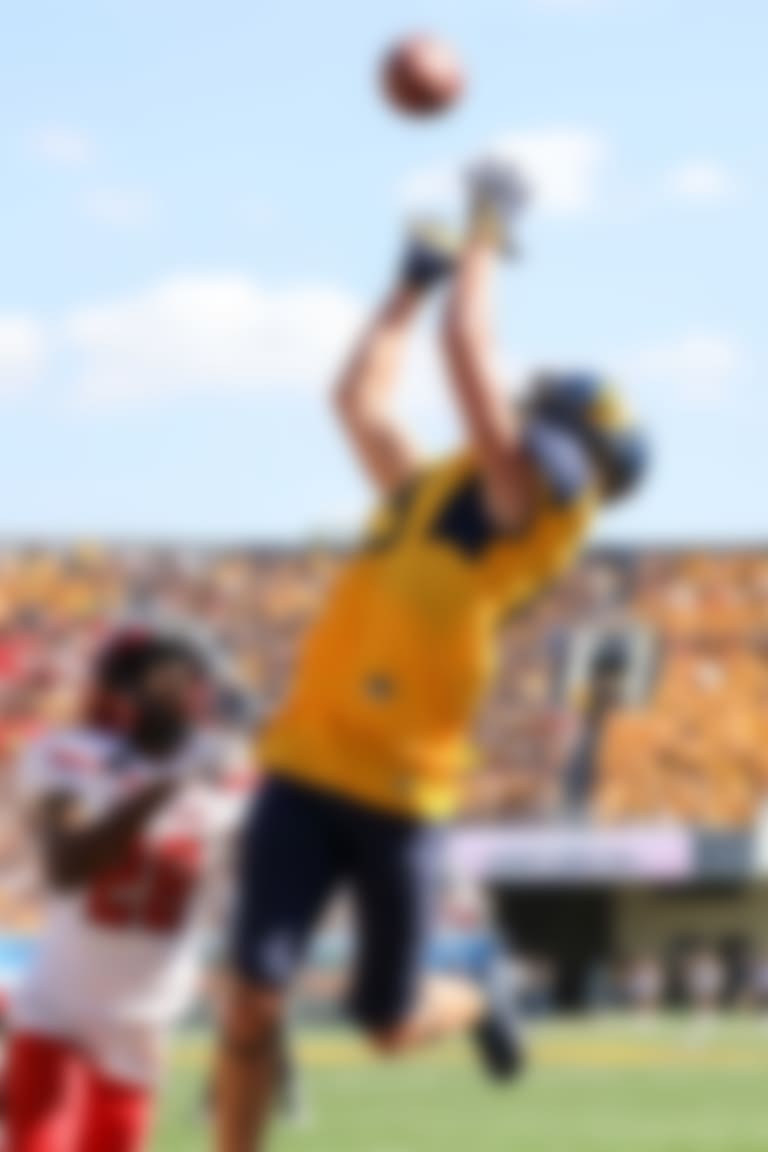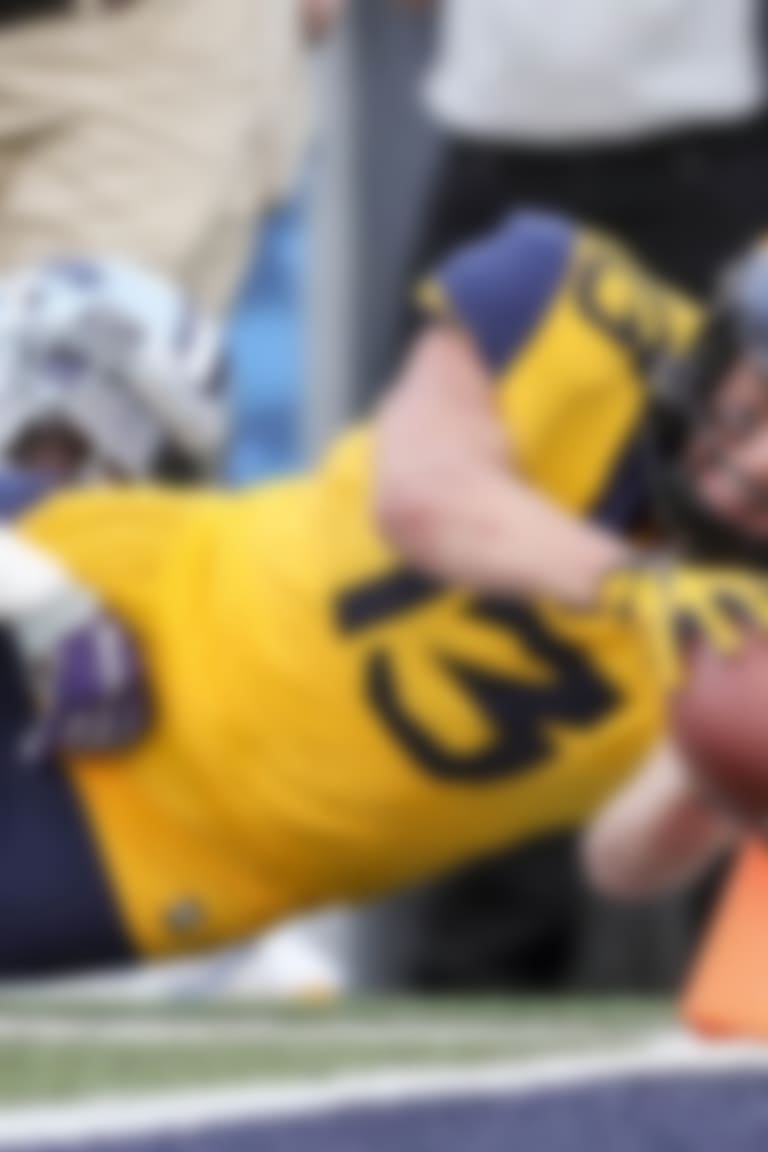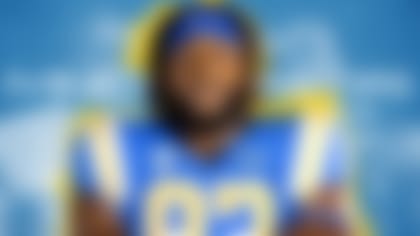At age 13, David Sills was recruited by Lane Kiffin to be the next great quarterback at USC. Eight years and a position switch later, he's ready for the NFL.
By Chase Goodbread | Published Oct. 9, 2018
MORGANTOWN, W.V. -- It sagged toward the back such that some nights he would wake up and find himself wedged under the back cushions, almost stuck, needing to reposition to free himself. Incalculably old and worn, the couch's original light brown color had given way to a more grayish tone, and sleeping on it could be unforgiving.
David Sills V's head always rested flat on the seat cushion, because sleeping with it on the armrest guaranteed a stiff neck in the morning. His calves crossed the opposite armrest if he unfurled his 6-foot-4 frame to its full length. That's how he preferred to rest, but if he awoke with numb feet from cut-off circulation, he'd curl up and roll to his side.
The dreams. The hype. The expectations. Two years ago, they all landed, with a thud, on Khaliel Rodgers' couch in a tiny studio apartment in Los Angeles.
Six years earlier, then-USC coach Lane Kiffin had made Sills the youngest star recruit in college football history, offering the quarterback a scholarship at the tender age of 13 before he'd ever taken a snap in a varsity high school game. A couple days later, "Good Morning America" put the wunderkind in front of a national television audience. This was the peak from which die-hard recruiting enthusiasts -- a massive segment of college football fandom -- began scrutinizing the career trajectory of a child.
Sills first walked through the door of Unit 106 in the Anatole Apartments just in time for the Fourth of July weekend in 2016. He surveyed Rodgers' studio and began figuring out how he could share just a few hundred square feet with one of his best friends without being an imposition. The two had been teammates and close friends since middle school, though Rodgers is older by two years. This tiny living space was small enough to put the compatibility of any two people to the test. There wasn't room for Sills' clothes, so the trunk of his Dodge Charger served as his closet for a few months. He kept a few possessions -- a laptop, a few rolls of football tape, a couple pairs of shoes and footballs covered with large scuff marks -- in a corner of the studio, as far out of the way as possible.
He was there to reclaim and redeem a quarterback career in which countless hours and dollars had been invested. A career that everyone but himself, his closest friends and maybe a few people who shared his last name had given up on.
He came to prove all the doubters wrong.
He left to prove something entirely different.
In a flawlessly clean dining hall for West Virginia football players, Sills sits on a cafeteria chair, politely skipping along the highs and lows of one of the greatest and most impossible tales college football will ever know. His neatly trimmed, short brown hair is a much more studious and mature appearance than the blonde, more moppish look he carried when America first saw his face at 13. Considering he's been asked constantly to update this saga since the day Kiffin made him famous almost a decade ago, he speaks with a remarkably calm and measured tone. And after nearly half an hour with an engaged, forward lean, he finally sits back and looks up. His first real reflection.
"Right now, I'm having the most fun I've ever had playing football," he says.
In 2017, his first full season to ever play wide receiver, Sills established himself as one of the best in the college game. His 18 touchdown catches led the nation, and with 15 more as a senior last year, he completed his career with an incredible average of more than a touchdown catch per game (35 in 33). His position coach, Tyron Carrier, describes a much more seasoned receiver than Sills actually is.
"He has great hands and comes in and out of breaks really well. He's smart, and he's gotten very physical on the perimeter," Carrier said. "And he doesn't give away routes, so you don't know if he's releasing inside or outside, breaking left or right, nothing. He makes everything look the same to the cornerback -- whether he's going to run past you, or block you, or run a 5-yard stop route."
An NFL career is coming for Sills, but the quarterback dream he relentlessly pursued from age 7 to 20 is now a pile of proverbial ashes, lost between those couch cushions back in Los Angeles. Near the end of his six months in L.A., he finally, painfully, acknowledged that the quarterback he'd always seen in the mirror was actually -- underneath it all -- a wide receiver scratching to be released.
Other than a limited foundation of experience, there is plenty for NFL scouts to like. At 6-foot-4 and 203 pounds, he's thin but wiry strong, with long arms and what Mountaineers QB Will Grier calls a "ridiculous catch radius." If Sills' testing results at the NFL Scouting Combine next week match what he's shown WVU strength and conditioning coach Mike Joseph, he'll broad jump 10-4, vertical jump 34 inches and run a 40-yard dash in the low 4.5s -- all impressive marks, given his size. Joseph used to be part of Notre Dame's S&C staff and sees athletic similarities between Sills and former Fighting Irish star WR Jeff Samardzija, who a decade ago passed on an NFL future for a Major League Baseball career as a starting pitcher.
Then, there is the ceiling factor. Sills' lack of experience as a receiver is, to WVU coach Dana Holgorsen, a potential strength where his NFL future is concerned.
"As good as he is, I think he's so far from what he could be," Holgorsen said. "He does things naturally, but as far as technique, he was behind last year. I'm not sure he really knew what he was doing, but he was catching touchdowns."
Steve Clarkson didn't know what to think. The youngest quarterback he'd ever trained was 13-year-old Jimmy Clausen, and the accomplished instructor considered 10 to be far too young for formal private training. Nevertheless, when David Sills IV called and asked Clarkson to merely look at his son for a one-time assessment, the QB guru agreed. The Sillses flew to Los Angeles from their home in Bear, Delaware, for the introduction, and Clarkson was amazed at the young quarterback's ability to mentally absorb and apply instruction.
"He showed me enough that I started asking myself, 'How young is too young?' " Clarkson said. "I had always felt like 10 was much too young, but I took it on, almost like an independent study."
To the public consciousness, Sills' story didn't begin until Kiffin's scholarship offer made national news, but the work that compelled that offer began years earlier. Sills began playing quarterback at age 7, and his gift for throwing a football was quickly apparent. At age 9, he was named the top quarterback at a week-long Philadelphia Eagles youth camp in West Chester, Pennsylvania. In another year, he was training with Clarkson regularly.
With Clarkson's business based in Los Angeles and the Sills family living in Delaware, cross-country flights were the only way the two could train together. Clarkson estimated the lessons came with monthly frequency, and at certain times of the year, it was Clarkson who flew to the East Coast rather than Sills and his father flying west. Eventually, Clarkson directed Kiffin to some video, without telling him Sills' age. Kiffin was impressed with the boy's arm and was blown away when Clarkson revealed the kid was only 13. Serving as an intermediary between Kiffin and the Sills family, Clarkson was shocked when Kiffin floated the idea of an immediate scholarship offer. When the offer was accepted, the news exploded.
"It wasn't taken very seriously. Everyone understood the kid could change his mind two or three times," Clarkson said. "But the idea that a school like that would offer a kid at that age, it just hit people like a bucket of ice water with their back turned. It startled people."
Sills' name was plastered across ESPN, and his subsequent appearance on "Good Morning America" provided the ultimate stamp of a cultural touchstone. The popularity that followed was overwhelming at times.
"It was a little scary," said Kenny Bigelow, a high school teammate who, after a few injury-riddled years at USC, re-joined his friend with a transfer to West Virginia. "People were asking if I was his body guard."
Kiffin was immediately criticized for what was thought to be an exploitative publicity stunt. To this day, he maintains his sincerity in the offer.
I DON'T REMEMBER IT BEING THIS HORRIBLE THING. IF IT WAS SO BAD, WHY IS IT NOW THE NORM? LANE KIFFIN
"I've never thought of it like a regret," said Kiffin, now the head coach at Florida Atlantic. "We offered a really young kid who was very talented. You don't know how they'll develop in certain areas, but you could see great feet. You could see gifts you're seeing now, you're just seeing them at a different position. There must've been a lot more backlash than I recall. I don't remember it being this horrible thing. If it was so bad, why is it now the norm?"
It's not, but Sills certainly blazed a trail for a few others that would follow, including Alabama LB Dylan Moses, who drew FBS scholarship offers at the same age, as did Kaden Martin, the son of USC offensive coordinator Tee Martin.
One impact of Kiffin's offer was that it put a target on Sills' back for opponents throughout high school. Talented pass rushers -- and there were some excellent ones, with the national schedule Sills' teams played -- wanted to make sure they got a good shot on the kid believed to have received the earliest scholarship offer in college football history.
On the field, they would speak openly about it. Rodgers would have none of it.
"I took it personally when guys talked like they were going to take him out," said Rodgers, who was ranked by Rivals as the nation's No. 1 offensive guard prospect in 2012. "It was disrespectful not just to him, but also to me, because I'm the guy protecting him."
Then, there were the attacks that no offensive lineman, no matter how big or protective, could shield him from.
"You Suck!!!"
"You can't throw for sh--"
"He's skinny and weak. What is USC thinking?"
Comments like these flooded a YouTube page to which Tim Kaub posted the first extensive public highlights of Sills. Kaub has worked with Clarkson for years, and at the time of Sills' commitment to USC, he ran Clarkson's social media.
As soon as Kaub posted clips of Sills competing in a middle school game as part of a promotional video for Clarkson's instruction, a deluge of nasty feedback spun his social media coordination role out of control.
"The vitriol in the comments, you would not believe," Kaub said. "I think every youth quarterback's dad in America commented, 'My kid is way better than this kid,' but it got much uglier than that, and I had to sit there and delete it all day. This was before YouTube got good at filtering. It was stuff that would be hurtful to a 20-year-old, and it was attacking a 13-year-old. I should've set it so nobody could comment, but my simple-minded football self eventually just deleted the videos altogether."
Kiffin had just been named head coach at USC at the time of the offer and was fired by the Trojans long before Sills ever reached college age. His replacement, Steve Sarkisian, told the Sills family he would honor the scholarship offer, but at the same time made it clear that Sills was not what he was looking for in a quarterback.
Looking back, David Sills IV doesn't consider Kiffin's scholarship offer to be a publicity stunt any more than Kiffin does, and he also doesn't believe it was a bad experience for his son. Still, if he could go back in time, he wouldn't allow his boy to accept it.
"I wasn't thinking, Hey, coaches get fired every 3-5 years. I was thinking Lane would be there," Sills IV said. "So, in hindsight, had I understood how much turnover there was in college coaching, I probably wouldn't allow it were it presented to me today."
Nov. 2, 2013 is a day Sills won't ever forget, but he looks down at his right hand and sees no reminder of it. There is no noticeable scar, no physical indication of how badly it was mangled, but it was the day the unraveling of his career as a quarterback began.
Sills' high school teams played a gauntlet of a national schedule, against powerhouse programs from Ohio to Florida to Texas, and a game against Lakewood (Ohio) St. Edward at the University of Penn in West Philadelphia took place on the day everything changed. In a brutally physical game, a St. Edward player's helmet crushed Sills' throwing hand, breaking a knuckle and causing significant swelling. Although he played through the injury, it permanently impacted his release.
Clarkson, who attended several of Sills' high school games, was there.
"He had taken a pretty good beating that day. His mom was like, 'Shut him down.' It was a football version of 'Rocky,' and she was ready to throw in the towel," Clarkson said. "All this in a stadium with a [Chuck] Bednarik statue, with the Rocky statue around the corner. It was pretty poetic."
Weeks later, Clarkson noticed Sills had changed the way he gripped the ball, and his release had developed a hitch because of the injury. He never again threw a football with the same fluidity, and the issue was noticeable to Holgorsen during the recruiting process at West Virginia. Holgorsen wanted Sills anyway, for his athleticism and obvious leadership skills, but didn't see a quarterback.
"To me, you just look at it and it's a yes or no," Holgorsen said. "If you have the release, and it's quick, and it looks how it's supposed to, then you look at accuracy, velocity, intelligence, footwork, all that other stuff. You know it when it's a no. And unfortunately for David, it was a no."
Sills, however, was still determined to be the Mountaineers' signal-caller.
"He would say, 'I'm a quarterback,' " said Landon Furry, one of Sills' best friends and his current roommate at WVU. "And that's not the same thing as saying, 'I want to play quarterback.' His mindset wasn't, 'This is the position I want to play.' It was more, 'This position is who I am.' "














